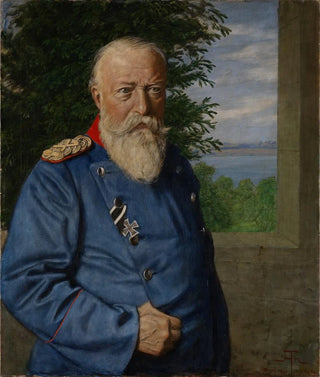Art print | Grand Duke Frederick I of Baden - Hans Thoma


View from behind

Frame (optional)
Frédéric I of Baden - Hans Thoma – Captivating Introduction
The artwork "Frédéric I of Baden" by Hans Thoma is a true immersion into the history and aesthetics of the 19th century. This painting, depicting the grand duke in a majestic stance, evokes not only the grandeur of the German monarchy but also the art of portraiture that has evolved over the centuries. Through this piece, Thoma manages to capture the essence of a historical figure while infusing it with an almost timeless dimension. The light, movement, and intricate details of the grand duke's attire demonstrate a technical mastery that leaves no one indifferent. As viewers contemplate this work, they are invited to imagine themselves in a bygone era, while questioning the values and symbols that shaped that period.
Style and uniqueness of the artwork
Hans Thoma's style is characterized by a blend of realism and romanticism. In "Frédéric I of Baden," he skillfully combines these two artistic currents. The carefully chosen colors harmonize to create an atmosphere that is both solemn and warm. The texture of the painting, rich and velvety, brings the scene to life, while the expressions of the grand duke reveal a strong and charismatic personality. Thoma also employs compositional elements that direct the viewer's gaze toward the face of the grand duke, emphasizing his authority and presence. Every detail, from the draping of his uniform to the ornaments surrounding him, is designed to reinforce the iconic character of this historical figure. This painting is much more than a simple portrait; it is a visual statement on power and dignity.
The artist and his influence
Hans Thoma, born in 1839, is one of the most respected artists of the German school of painting. His work is marked by a deep sensitivity to nature and everyday life, which has allowed him to create pieces that resonate with the public of his time and beyond. Thoma was influenced by the Romantic movement, but he also knew how to incorporate elements of realism, enabling him to stand out.

Matte finish

View from behind

Frame (optional)
Frédéric I of Baden - Hans Thoma – Captivating Introduction
The artwork "Frédéric I of Baden" by Hans Thoma is a true immersion into the history and aesthetics of the 19th century. This painting, depicting the grand duke in a majestic stance, evokes not only the grandeur of the German monarchy but also the art of portraiture that has evolved over the centuries. Through this piece, Thoma manages to capture the essence of a historical figure while infusing it with an almost timeless dimension. The light, movement, and intricate details of the grand duke's attire demonstrate a technical mastery that leaves no one indifferent. As viewers contemplate this work, they are invited to imagine themselves in a bygone era, while questioning the values and symbols that shaped that period.
Style and uniqueness of the artwork
Hans Thoma's style is characterized by a blend of realism and romanticism. In "Frédéric I of Baden," he skillfully combines these two artistic currents. The carefully chosen colors harmonize to create an atmosphere that is both solemn and warm. The texture of the painting, rich and velvety, brings the scene to life, while the expressions of the grand duke reveal a strong and charismatic personality. Thoma also employs compositional elements that direct the viewer's gaze toward the face of the grand duke, emphasizing his authority and presence. Every detail, from the draping of his uniform to the ornaments surrounding him, is designed to reinforce the iconic character of this historical figure. This painting is much more than a simple portrait; it is a visual statement on power and dignity.
The artist and his influence
Hans Thoma, born in 1839, is one of the most respected artists of the German school of painting. His work is marked by a deep sensitivity to nature and everyday life, which has allowed him to create pieces that resonate with the public of his time and beyond. Thoma was influenced by the Romantic movement, but he also knew how to incorporate elements of realism, enabling him to stand out.






